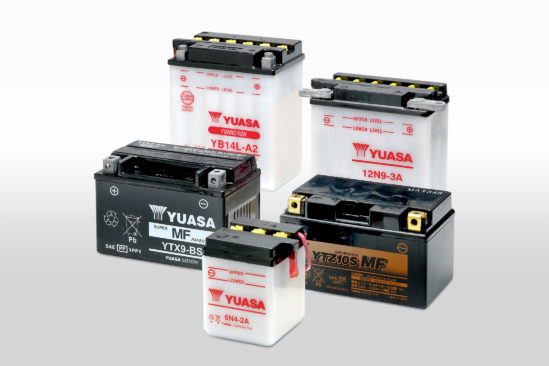
Motorcycle batteries require proper storage and maintenance during the winter.
How to Maximize the Batteries‘ Service Life
With the beginning of the cold season, the winter standing period of motorcycles quickly approaches. Batteries will then be used rarely or not at all, whether in the motorcycle or in storage. Therefore, GS YUASA would like to share some hints for workshops, dealers and their customers about how the service life of batteries can be prolonged through appropriate storage and maintenance procedures.
Charging during the standing period: Batteries should be fully charged all the time to avoid any damages. Charging will be no problem if the motorcycle is used for more than 10 minutes in regular intervals (if the generator functions properly). However, the battery will not be fully charged if the motorcycle is not used for extended periods of time or if only short journeys are made in irregular intervals. After all, the battery must supply electrical loads including safety systems, immobilisers and ECU memories in addition to its normal self-discharge.
Therefore, it is recommended to connect a smart charger if the motorcycle is not used for a longer time. Smart chargers ensure that the battery is monitored and maintained safely. In addition, they maintain the optimum voltage during longer standing periods in winter, ensuring the continuous operation of any assistance systems and the ECU memory. The charger’s manual will inform you whether the device provides a maintenance mode and if it can be used for unattended charging, as ensured by GS YUASA’s chargers.
Correct storage: Ideally, batteries are stored in a dry place at temperatures between 15 to 20 degrees Celsius. Motorcycle batteries will lose charge if not stored properly. If the state of charge of a battery is too low, it will be impossible to reactivate it. When the open-circuit voltage (OCV) drops to 12.4 V, it is imperative to charge the battery immediately. Therefore, GS YUASA recommends to regularly check the OCV with a digital voltmeter and to recharge the batteries especially during the winter.
Use a maintenance plan: Adhering to a maintenance plan will additionally extend the service life of batteries. The following is an example of a typical maintenance routine depending on the specific battery model: First, disconnect the motorcycle battery’s negative and positive terminals from the motorcycle and put the battery on a clean, flat surface in a well-ventilated place. Check for any corrosion on the battery terminals and clean with a wire brush if necessary. Remove the caps and top up distilled water to the specified level (only for non-maintenance-free batteries). Finally, press in or screw the caps again firmly.
GS YUASA offers a wide selection of different battery models and smart chargers for motorcycles. www.yuasa.com
Therefore, it is recommended to connect a smart charger if the motorcycle is not used for a longer time. Smart chargers ensure that the battery is monitored and maintained safely. In addition, they maintain the optimum voltage during longer standing periods in winter, ensuring the continuous operation of any assistance systems and the ECU memory. The charger’s manual will inform you whether the device provides a maintenance mode and if it can be used for unattended charging, as ensured by GS YUASA’s chargers.
Correct storage: Ideally, batteries are stored in a dry place at temperatures between 15 to 20 degrees Celsius. Motorcycle batteries will lose charge if not stored properly. If the state of charge of a battery is too low, it will be impossible to reactivate it. When the open-circuit voltage (OCV) drops to 12.4 V, it is imperative to charge the battery immediately. Therefore, GS YUASA recommends to regularly check the OCV with a digital voltmeter and to recharge the batteries especially during the winter.
Use a maintenance plan: Adhering to a maintenance plan will additionally extend the service life of batteries. The following is an example of a typical maintenance routine depending on the specific battery model: First, disconnect the motorcycle battery’s negative and positive terminals from the motorcycle and put the battery on a clean, flat surface in a well-ventilated place. Check for any corrosion on the battery terminals and clean with a wire brush if necessary. Remove the caps and top up distilled water to the specified level (only for non-maintenance-free batteries). Finally, press in or screw the caps again firmly.
GS YUASA offers a wide selection of different battery models and smart chargers for motorcycles. www.yuasa.com

GS Yuasa motorcycle batteries
To stay up to date with Yuasa’s products and latest news, visit: www.yuasa.com
GS YUASA is one of the largest manufacturers and suppliers of rechargeable batteries with production facilities worldwide and an extensive marketing and distribution network in Europe. The wide range of lead-acid and lithium-ion batteries covers most well-known industrial applications, such as security and alarm systems, UPS and emergency lighting systems as well as OEM equipment. The three business units include Industrial (industrial batteries for standby and cyclic applications), Automotive and Motorcycle (automotive and motorbike starter batteries).
GS YUASA Battery Germany GmbH, founded in 1983 as YUASA Battery (Europe) GmbH, is based in Krefeld and serves 15 countries within Europe from there.
GS YUASA Battery Germany GmbH, founded in 1983 as YUASA Battery (Europe) GmbH, is based in Krefeld and serves 15 countries within Europe from there.
GS YUASA is sponsor of the Yamaha Teams im Motocross GP.
GS YUASA is sponsor of the Repsol Honda Teams HRC in der MotoGP.
GS YUASA is sponsor of the GERT56 Racing Teams.



